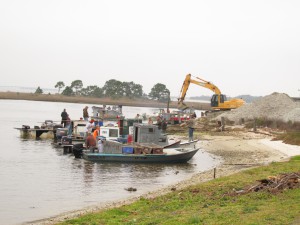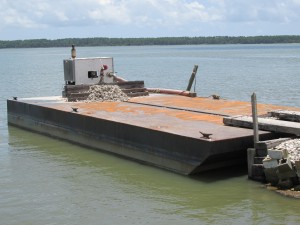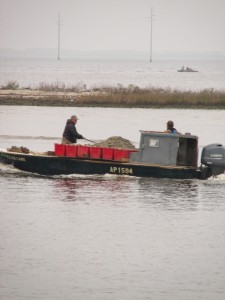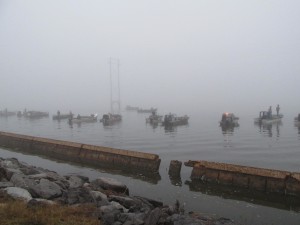Nature has provided us with an incredible resource in the diverse assemblage of molluscan shellfish that inhabit our coastal bays and estuaries. One bivalve species in particular provides many human benefits. The eastern oyster (Crassostrea virginica) has not only proven to be a preferred food species for people but also derives many vital ecosystem services through its existence in our near-shore estuaries. Oysters are born as planktonic larvae that drift in the water for about 2 weeks. They are called a spat when they settle out of the water column and glue themselves to a suitable hard surface, such as another oyster shell, and begin to grow their own shell. Oysters feed on particulates in the water throughout their life and when mature can filter as much as 50 gallons per day. Because of this life style they provide some degree of water purification and improvement in water clarity. The structure of an oyster reef is also a valuable habitat component which provides shelter for a plethora of small creatures that support a vast food web in the estuary ecosystem.
Although we have several native species of oysters in the Gulf of Mexico the eastern oyster is the only species that supports a commercial industry. in Florida, the bulk of that industry has traditionally been centered around Apalachicola Bay in the mid-Panhandle region of the state. This one estuary system typically produces 90 percent of the state’s oyster crop and 10-13 percent of the nation’s harvest. Some good harvest years have yielded 4-6 million pounds of oyster meat (shells excluded) from this single bay. In recent years however there has been a dramatic decline in oyster abundance. The industry, along with concerned natural resource managers, is seeking to rebuild numbers to a sustainable harvest level. The reasons for this precipitous drop in numbers is the subject of much debate but savvy natural resource professionals believe a combination of factors have been involved over several years to cause the current situation.
So, how do you bring back a thriving oyster industry from the brink of collapse? Several factors need to be considered and addressed as part of a holistic management approach. At the present time there are two primary mechanisms being employed to support increased oyster recruitment to Apalachicola Bay. The first involves “planting” a suitable material on the bay bottom for oyster spat attachment and growth. In the past this has primarily consisted of oyster shells from the shucking plants. More recently the industry has been employing the use of fossil shell material from a local mine. Oystermen are being employed to transfer the shell from land-based loading areas to the designated deposition sites in the bay. Funding is also forthcoming to allow shelling by barges to cover more area. The other strategy to assist with recovery has involved the use of regulatory authority in consultation with local experts and oystermen with decades of experience on the bay. This approach can reduce the harvest pressure on oysters and support a more rapid recovery, given proper conditions in the estuary. Bag limits have been reduced, enforcement has been stepped up to ensure compliance with the rules, and harvest areas have been adjusted.
There are, of course, other important aspects to the solution for bringing back the thriving industry of the past and many of them relate to natural cycles of drought and flooding. Increasing human demands for water from the river system that feeds the bay tend to magnify the effects of natural drought cycles. If salinity remains high for longer periods there is an increased pressure from oyster predators that typically are limited by lower salinity. Factors related to oyster diseases and parasites are also in the mix. To say that it is a complicated situation would be an understatement. Researchers who have studied the system for their entire careers find it difficult to quantify the problems and solutions for this large, complex natural ecosystem that has been an important cultural and economic component of Florida’s makeup since early humans roasted or cracked open the first oyster. Hopefully, with enough concerned partners working towards effective management strategies we can once again enjoy in abundance the wholesome, delicate morsels that have been called the food of the gods.
Article by: Erik Lovestrand
Franklin County Extension Director
Sea Grant Regional Agent II
- Recent Catch of a Bocourt Swimming Crab in Apalachicola Bay - November 22, 2024
- Damselfly Love - October 18, 2024
- Meet the Ocellated Flounder - June 28, 2024




